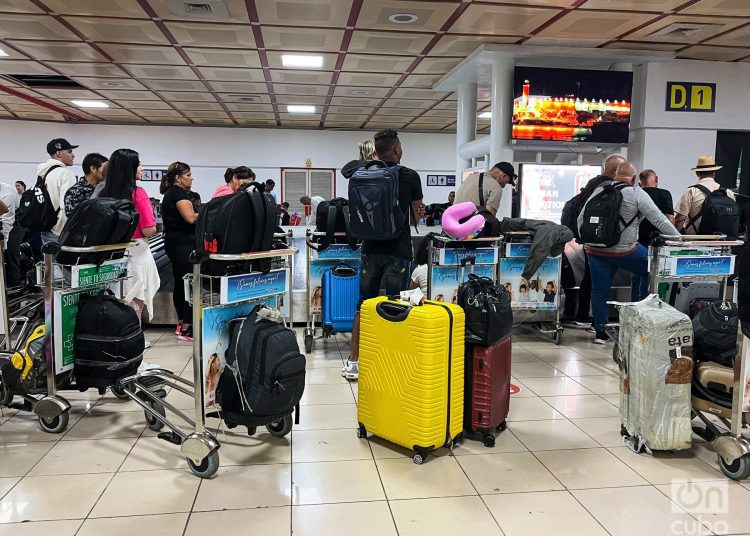“We all have the perception that it is practically impossible for a family in Cuba not to have at least one member abroad,” said Cuban diplomat and political scientist José Ramón Cabañas. And indeed, almost 11% of the Cuban population is today outside the island. But, beyond the statistics, his words reflect a common and widespread feeling: we all know someone who has left, is about to leave, or has medium or long-term plans.
The current migratory wave, particularly acute since the second half of 2021, has a multi-causal character. Family and economic variables (search for better salaries and living conditions), communication through the Internet, and the desire for professional fulfillment, not just monetary, play an important role as an incentive for migration; according to Antonio Aja Díaz, researcher and director of the Center for Demographic Studies (CEDEM). Of course, political issues also influence, in his opinion.
All these aspects are interwoven and contribute to the decision to emigrate. But, as the expert himself has emphasized, it is individual experience that decides a future displacement. It is the individual, in his micro universe and affected by all the previous variables, who, ultimately, defines whether he leaves or stays.
Thus, the recognition that among the causes that motivate the migration of Cubans is the fact that they face a crisis of individual expectations in the face of collective problems becomes particularly relevant.
What has been theoretically defined as a crisis of expectations is a perception of “uncertainty, insecurity, distrust [and] imprecision in future projects.” Such feelings, when combined, become as important as the family itself when making decisions associated with leaving the country, says researcher Consuelo Martín Fernández.
From the individual to the social, and vice versa
The individual crisis is directly associated with the context in which the human being develops. National crisis situations, mainly economic, have a link with migratory waves, also in the Cuban case — although it is not an exclusive fact of the country.
Specialists agree that within the multicausality of the island’s migration process, “the unfavorable economic situation” is located as a predominant trend in time, although the crisis of the 1990s stands out for the most part.
However, between 1990-1997, 164,298 Cubans left the country. Several thousand were concentrated in the so-called rafter crisis, in which some 35,000 people left for the United States — the main destination of Cuban emigration — in about five weeks (in the summer of 1994). Meanwhile, recent data confirms that between January 2022 and last June 2023 — just eighteen months —, 368,000 Cubans were intercepted at the border of that country.
The figure exceeds all the emigration in the 1990s, and also exceeds the departure of around 125,000 migrants between April and October 1980 through the port of El Mariel; although the nature of the latter — it is worth specifying — differs from current events and those of 1990, in the fact that its predominant causes were, fundamentally, inadaptation and social rejection.
Of course, in the migratory waves of the 1980s and 1990s the conditions were not like the current ones in terms of mobility. Today we can recognize a relaxation of the rules for leaving the country that did not exist then. The immigration reform promoted by Raúl Castro’s government in 2012 lifted the main restrictions so that individuals could travel abroad. Of course, the difference in the figures does not depend only on this, but it is a fact that undoubtedly, and this is recognized by researchers, has influenced the behavior of this social phenomenon.
But, in essence, why do Cubans emigrate? As explained by Antonio Aja, “migration is, essentially, a consequence of other processes and not a cause.” In this sense, in most cases migration is “the way out of so many social, economic and political dysfunctions.”
The island has been going through its most recent economic crisis for nearly five years. Within the current Cuban context, in which policies and measures that have had unexpected negative results have had an indisputable weight — the Regulation and the sale of basic goods in freely convertible currency —, the individual decision to migrate has also become an expression of discontent in the face of these policies, which make the daily lives of Cubans difficult.
The life story of a young rafter who, upon being returned to the country, was interviewed by Jany Bárcenas, is an expression of the above. “I left on a boat because my mother can’t have a card in freely convertible currency,” he said when asked about his motivations, “and in the town where I live, in the center of the country, almost all the stores sell in that currency; that is the reason, I have no other reason.”
The family has had and has a definitive weight in the decision to migrate. Experts agree that the only permanent trend throughout the entire Cuban immigration process that is perceived to be increasing is family reunification. But, as evidenced in cases such as the one mentioned above and other similar ones, not only is the family that attracts from abroad defining, but also and particularly in the current scenario on the island, the decision to migrate to become a support for those who they are left behind.
In a context of rampant inflation exacerbated after the Reorganization process that led to a profound devaluation of the national currency, access to foreign currency becomes essential, while all basic goods are marketed on the island in this currency.
Precisely, as recognized by Raúl Castro in the Report to the 8th Congress, “sales in freely convertible currency were extended to other products, including food, with the objective of encouraging the remittances that Cuban citizens who live abroad send to their relatives in the national territory.”
The country needs foreign currency and to live in Cuba people need to have it, but many Cubans do not receive remittances. The data on family units that do not have some type of financial assistance from abroad is not public on the island, but it is known that this factor makes them part of the most vulnerable sectors.
Without the financial support of a family remittance from abroad, Cubans’ income has limited real value. A peremptory solution to this need for remittances is the emigration of young people of working age, who leave Cuba “to be able to help their family.”
Mujeres afrodescendientes en Cuba y la Tarea Ordenamiento (I)
As experts affirm, “crisis situations exacerbate the need to search for strategies to confront them.” One of the most worrying aspects of the current migration crisis is the fact that it is motivated by a “search for well-being, which is no longer perceived in Cuba, which is thought to be impossible to achieve on the island,” as Jany Bárcenas emphasizes.
The temporary or permanent exits offered by migration are perceived today as the only possible solutions to the scenario in which we live and the hopelessness it generates.
Return is more than the name of a tango
In demographic terms, the departure of its young people of working age, qualified or educated, is a challenge for the nation. For a population of just over 11 million, having 11% abroad is having no less than a million of its nationals contributing to other economies.
Cuba is the oldest country in Latin America and the Caribbean, with 22.3% of the population aged sixty or older. Within five years we will have about 28% and we will only have 10 million inhabitants.
The worst thing is that this trend is not being reversed. According to Antonio Aja, the symptoms of irreversibility are evident in “low fertility, which will not essentially change,” and also “the population that is lost annually.” And when we talk about a population that “is lost” we are referring to those who, upon leaving the country, do not plan to return to live on the island.
Without a circular migration process, population decline and aging, two phenomena also linked to migration, will only mean in the future that Cuba will have less population for everything.
Every young Cuban today faces a specific dilemma: the possibility of remaining within the family, with those they love, and trying to carry out a life project in their country; or the option of migrating to be able to access better salary and living conditions and become an “economic support” for those same loved ones who remain behind.
In the opinion of the psychologist and professor Jany Bárcenas, it can be understood that “when someone lives in constant hopelessness and returns again and again to the crisis of expectations about their personal, family, and social well-being, of course, they evaluate the decision to remain in their country.”
A circular migration would benefit the Cuban economy. The young people who leave are not sure if they want to live on the island again. Many do not close the door to the possibility, but their terms are understandable when they say that they would return “perhaps; if Cuba improves.”










